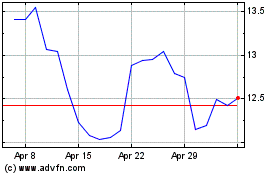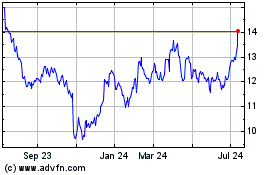By John D. Stoll
Jim Farley joined Ford Motor Co. when print ads and 30-second
television spots were the way to sell an automobile. A decade
later, the world's digital transformation has the No. 2 U.S. car
maker rethinking how it allocates its $4 billion-plus advertising
budget, and how much can be cut.
As president of global markets, and Ford's No. 2 person, Mr.
Farley has a sprawling mandate, from overseeing driverless cars to
shepherding sales in dozens of countries. Executives working for
him are scrambling to be more creative, with the North American
management team, for instance, now working entirely without
desks.
Mr. Farley's bottom line: Ford can get better, even as it
stretches to get its spending under control. "Having a cost problem
makes it more important to be curious and find a better way," he
says. This means finding even more ways to use platforms like
Facebook Inc. as a core selling tool, and looking to entertainment
providers, including Netflix Inc., to produce today's auto ads.
Mr. Farley spoke to The Wall Street Journal about how rapid
changes in the marketplace are influencing a 115-year-old company.
Edited excerpts follow:
Tighter belt
WSJ: Ford is talking about dramatic cost-cutting in the name of
what it calls financial "fitness," including putting its longtime
advertising account with WPP up for review. What is driving
this?
MR. FARLEY: The digital platform to engage with customers is big
enough and the targeting tools are precise enough now that we can
make private offers to customers. So it was pretty clear that we
needed a new model.
That "fitness" work really questioned the basics of what gets
in-sourced; what the agency does; what kind of talent we need, and
how efficient can it be. The biggest change is not the agency --
it's us.
WSJ: So you believe advertising is a place you can be more
efficient?
MR. FARLEY: Creative development and placement of the ads for
digital can be done by machines and software. In the past you would
kind of position your brand in a search with Google, for instance,
and you would have these programs that would help with the search
algorithms. We've now moved past that, where if you look at, say,
Netflix, they are modifying the creative based on viewers'
behavior; they're instantaneously making the creative
different.
WSJ: How does this apply to car selling?
MR. FARLEY: Let's say I'd like to talk to Lincoln Navigator and
Ford Expedition owners. Most of those customers are in just a few
ZIP Codes. You could say: "I want to serve up an ad to people in
Ann Arbor who have not done a search for full-size SUV nameplates
in the last three years but have the words Expedition, Chevrolet
Tahoe or Cadillac Escalade somewhere in their Facebook newsfeed.
And they've had at least two conversations about those in the last
three months." You may be able to do it through an agency, or you
may be able to do it direct.
WSJ: What does this say about using platforms like the National
Football League?
MR. FARLEY: Those large venues still matter. For our truck
customer, the NFL is really important. If we have a new Super Duty
truck, we're going to tell people on a big platform that fits the
customer. People have to find the brand in the right places and the
right ambience. Most important is when you're talking to them, it's
personal and one-on-one.
WSJ: Sounds like you need to develop new skills?
MR. FARLEY: The digital piece that people engage with today is
an online video that grabs your attention in two seconds. And who
knows those kinds of skills? It's not the traditional people who
design 30-second TV ads or one-page print ads.
Using platforms
WSJ: How do you change the way you sell in a business that is
more than 100 years old?
MR. FARLEY: Digital advertising. And talking to people. We went
to Google and Facebook. They have software, targeting, to serve up
ads to specific audiences using their platforms. At Facebook we
would say, for example, please show a Ford Expedition ad to someone
who lives in Birmingham, Mich., who has family sports in their news
feed, has a picture of a GMC Yukon or Chevy Tahoe in their
pictures, and has googled new SUVs in the last week.
You have to ask yourself: Who is your best customer? Who is your
most difficult customer? Who is the customer that uses most of your
software tools? Who is the most data-analytics-driven customer?
Then go talk to them on the platforms where they are. It's just the
process of being curious about the right things and getting out of
Detroit.
WSJ: What are you learning as you get out of Detroit?
MR. FARLEY: We need, as an industry, much more professionalism
and deeper thought into how customers use the product in reality.
We did a leadership-team event in North Carolina and we all rode
around in vehicles. Now that sounds really simple, but it was one
of the most fascinating days I've had in the auto industry.
We think we know everything, and then you're with a single mom
who has two jobs, somehow has to get her kids to school and has to
do everything on 75 cents on the dollar. They're not technologists,
they don't know how our navigation system works and when you get in
their car and they have three phones attached to the dashboard,
they're driving with their knees and you can see all the scuff
marks in the center console where she throws her purse every day,
you start to look at your product differently. It was a huge "aha"
moment for most of us.
WSJ: What are customers telling you about the types of cars they
want? Is the crossover craze here to stay?
MR. FARLEY: Customers change in fits and starts. If someone
wanted a family vehicle in the '70s, they bought a station wagon.
Then Hal Sperlich came along with the Chrysler minivan, and it was
a new form factor that was quickly superior to station wagons.
Then customers shifted to SUVs, and the reason they shifted is
they get superior function and image. These changes happen every
10, 20 years. We are starting to see a silhouette shift again. The
battery-electric vehicle allows you to put the electric components
low and on the corners. You can move the wheels out and give the
customer more interior room for the same overall length. [Examples
include the Porsche Cayenne, Lamborghini Urus, and certain Peugeots
and Renaults.]
We could really see a change again. But if you execute it wrong,
people don't find it all that interesting. If you execute it right,
like Chrysler did with the minivan or Ford did with the Explorer,
it's magic. Absolute magic. Lightning in a bottle.
WSJ: Where does all this transition in the business leave the
thousands of dealers who sell your cars in the U.S. and have their
own independent businesses? Can you bring them along with the
changes you are making?
MR. FARLEY: Dealers will be very important. I think we're going
to see a shift. Their ability to manage a fleet of vehicles, keep
them maintained and clean -- that's a new business.
When I see the best of our dealers, many of them are in the
commercial-service business. The autonomous vehicle will be the
same kind of product. They're going to have high mileage. Someone
needs to be looking after that fleet, and constantly, every hour of
the day, making sure that fleet is running well, clean,
professional and serviced. I think that's going to be a new
business for our dealers.
Mr. Stoll is a reporter for The Wall Street Journal in Detroit
and writes the Full Disclosure column. Email
john.stoll@wsj.com.
(END) Dow Jones Newswires
May 20, 2018 22:28 ET (02:28 GMT)
Copyright (c) 2018 Dow Jones & Company, Inc.
Ford Motor (NYSE:F)
Historical Stock Chart
From Mar 2024 to Apr 2024

Ford Motor (NYSE:F)
Historical Stock Chart
From Apr 2023 to Apr 2024
